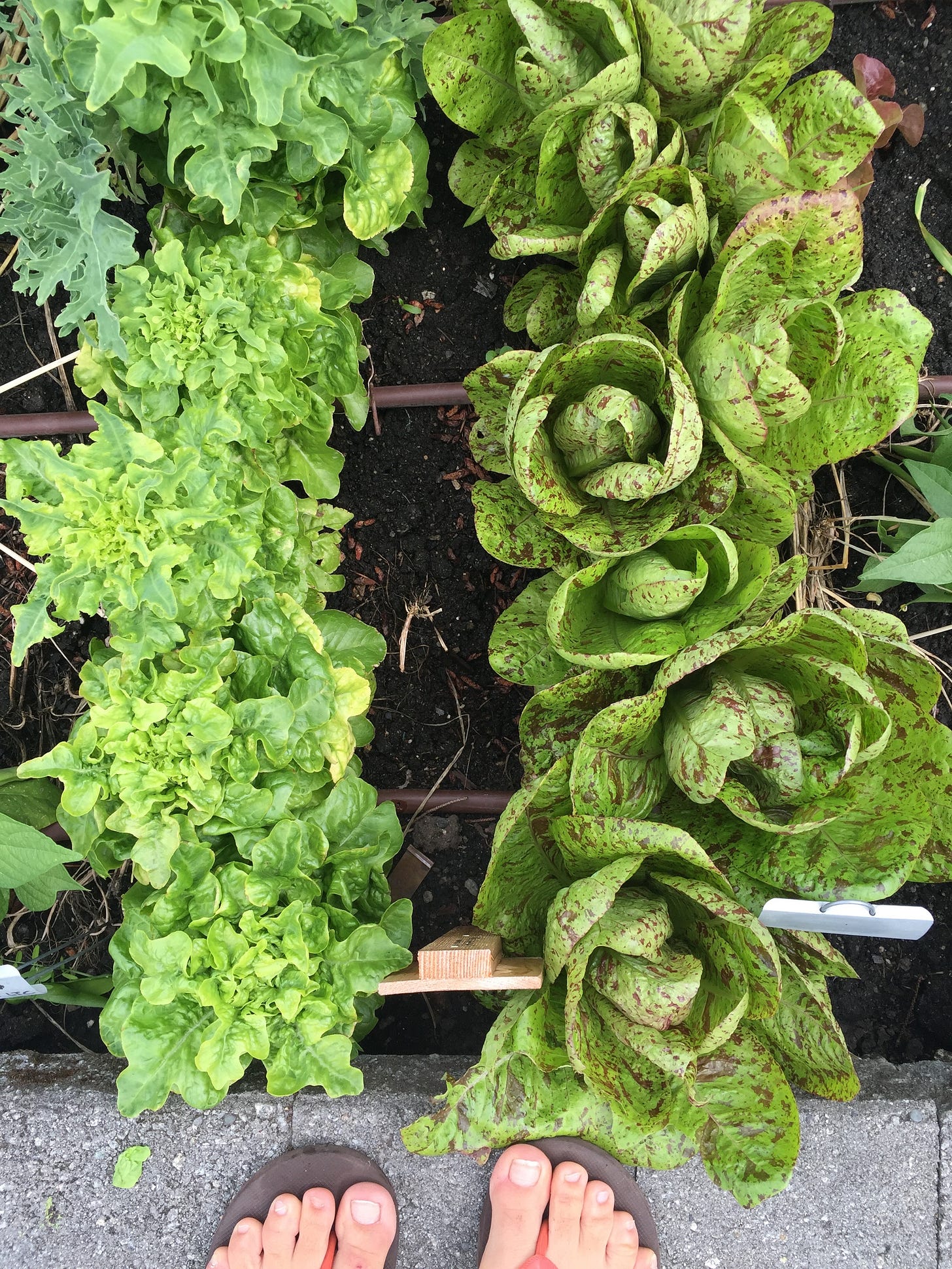It’s real, real hot out there. So, what should we be doing in the gardens??
Short answer: NOT MUCH.
Intense times of heat are not good times for new plantings. Heat stresses limits plant growth and development. Heat also exacerbates evaporation, making vulnerable shallow-rooted starts more susceptible to failure as they can’t take up water faster than it evaporates into the atmosphere. Just like with humans, strong roots equal a healthy plant and no one can really put down a strong foudation when the weather is causing external stress. Extreme heat negatively impacts root development, which therefore negatively effects the harvest. Simple as that.
The BEST plan for the next few days (and while our temps remain in the high 80s and into the 90s) is to schedule in an evening watering. Typically, in the PAC NW we steer clear of evening watering, as our nights are cool and plants don’t like wet roots, but in these conditions?? WATER IS YOUR FRIEND.
Water once in the early morning (as you should be doing every day, every summer) - sometime between 4-8am. ADD IN an evening watering somewhere between 5 - 8pm. I like to think of this as cocktail or nightcap hour. Pour yourself a g+t (or a lovely herbal elixir) and go water by hand. It’s fun and a good time for you to get up and personal with your garden. Remember to water low, when possible - try not to water plants from above, as water sits on leaves and may cause additional stress.
For anyone growing in containers, water deep and water often - maybe 3 or 4 times a day. Containers dry out quickly and demand more attention.
This is a great time of year to pay attention! Look at your plants - watch what they do as temperatures rise and fall. Nothing I write here will ever be a more powerful education than your sense of observation and intution. Engage those senses! Stay home, stay cool and tap into your plants.
HOW TO PLAN A GARDEN WHEN YOU ONLY HAVE ONE BED
Not everyone has a sprawling back yard big enough to hold multiple vegetable beds, and it is often the case that gardeners are working with one bed, like those of you in P-Patches. (I’m looking at you Max, Caitlin & Amy B!)
A fellow paid subscriber recently asked - “Do you have any resources or recommendations for working in a single bed? I'm cobbling together suggestions about rotation and sun from that, but curious if you could maybe do a newsletter with special considerations?”
Oh, the p-patch garden hustle! I been there. I will always recommend a fertility rotation to gardeners. This is the best way to ensure you have healthy soil (imperative as you continue growing in the same space over a handful of years), deter pests (moving crops around confuses them - planting the same thing over and over conditions them), and increases nutrients available to plants (allowing you to steer clear from adding ammendments that inevitably run off into our sewers, into our water system, into the lakes where it supports aquatic noxious weed growth like ‘Myriophyllum spicatum’ (Eurasian Water milfoil’).
CHOOSE YOUR OWN APPROACH
Divide the plot or bed you’re working with into two equal portions, and use a L/R, Fl/Fr fertility rotation. In spring, one side would be L/R the other, Fl/Fr. In June, I'd flip the rotation. This allows you to get the most plants in the smallest space, as you don’t have to steer clear of any of the families. This map is a good visual explanation of this.
In small beds, sometimes you don’t even have space to interplant, so you have to follow a fertility rotation slowly, as the season progresses.
Follow a fertility rotation, one by one. Start by planting a Leaf rotation in September: lettuces, kale, spinach, cilantro, scallions, small bulbing onions. After winter, plant a root rotation: radish, carrot, beets or turnips. Then in June, you’re ready for some summer crops. Plant a Flower/Fruit rotation: tomatoes, cukes, zucchini, beans and it’s easy to mix in flower here, like marigold and borage. Then again in September, plant a L/R rotation similar to March, and start the cycle over again. Conversely, you can plant a cover crop in September and let the plot lay fallow over winter, picking up a Leaf rotation in March.
I know someone will have questions about this, so please do ask for whatever clarification you need in the comments.
Be chill out there, friends! And remember, when in doubt YOU ARE MORE IMPORTANT than your plants, so if you feel in anyway stressed or compromised, think like a plant and lay low, drink water & spray yourself down throughout the day.
Heat Waving-ly Yours,
amy OXO






A belated thank you for this newsletter on small plot gardening! I’ve been moving my hodgepodge p-patch into a slightly more organized rotation and am getting ready for a winter season! Seeds went in 3 weeks ago, hoop house going up this week, starts to follow. I’m so excited to keep following your tips for a winter growing season!
Did I miss the talk with n pruning your tomatoes? I made a trellis like you recommended but I don’t know what to do with the side branches. Thanks Angie